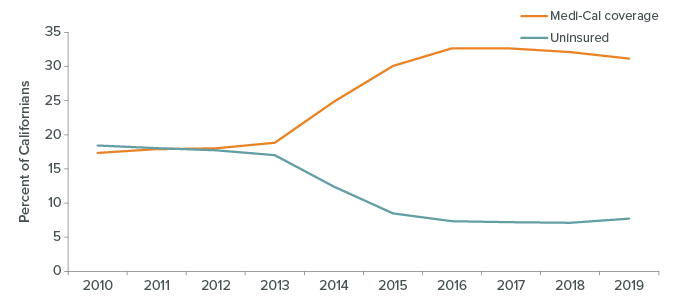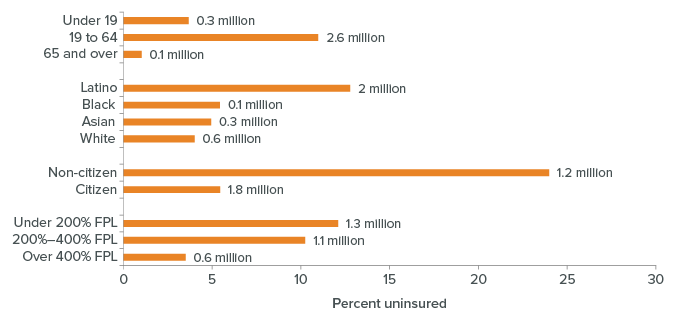News
PPIC: Amid pandemic, Medi-Cal enrollments rise
 Offices of Covered California, a health insurance portal for California's portion of the Affordable Care Act. (Photo: TonelsonProductions, via Shutterstock)
Offices of Covered California, a health insurance portal for California's portion of the Affordable Care Act. (Photo: TonelsonProductions, via Shutterstock)While we still do not know the exact impact of the pandemic on health coverage, available evidence suggests that sizable employment losses in 2020 may not have affected uninsured rates much. Nationally, estimates indicate the uninsured rate did not change in the first half of 2020 and analysis of administrative data suggests losses in employer-based insurance were small and may have been offset by enrollment in Medicaid. In California, we have seen steady increases in Medi-Cal (California’s Medicaid program) enrollment since April 2020, with caseloads about 9% larger in January 2021 compared to January 2020.
Expanded Medi-Cal coverage is responsible for much of the decline in the uninsured rate

SOURCES: American Community Survey (ACS), 1-year PUMS, 2010–2019. California Department of Health Care Services, Medi-Cal Certified Eligibles Tables by County, 2010 to Most Recent Reportable Month (March, 2021), downloaded from the CHHS Open Data Portal. California Department of Finance (DOF).
NOTES: Uninsured rates are based on self-reported survey data from the ACS and are subject to greater error than the administrative data used for the Medi-Cal coverage rate, which shows annual January Medi-Cal enrollment counts, excluding undocumented immigrants in limited scope Medi-Cal, divided by annual state population estimates.
ACA coverage expansions likely helped keep many Californians insured.
After coverage expansions under the Affordable Care Act (ACA) took effect in 2014, California’s uninsured rate declined substantially from 17% to about 7%, where it has held steady since 2016. California’s decision to expand Medi-Cal to cover most low-income adults without children or a qualifying disability was responsible for much of these gains. As of January 2021, Medi-Cal provided comprehensive health coverage to about 12.6 million residents, nearly one-third of the state’s population. Most Californians with low and moderate income levels who do not qualify for Medi-Cal can purchase health insurance through Covered California, the state’s insurance marketplace, and receive federal and state subsidies to cover the costs. Between 1.2 and 1.6 million Californians annually have purchased health insurance through Covered California since its creation in 2014.
ACA reform has been linked to improved outcomes.
A substantial body of research generally agrees that ACA Medicaid expansions improved access to and use of health care, reduced disparities across racial/ethnic, income, and education groups, and increased financial security for individuals and hospitals. Recent studies have shown that Medicaid expansion is associated with decreased mortality overall and for certain conditions; it has also been linked to reductions in poverty rates, food insecurity, and home evictions.
California passed state-level reforms to protect ACA coverage gains . . .
In response to the Trump administration’s repeal of the individual mandate (the requirement that people have health insurance or pay a tax penalty) and funding cuts for outreach and enrollment, California passed state-level health reforms to protect its coverage gains. These included offering state subsidies to purchase insurance though Covered California and the creation of a state individual mandate. In 2020, new state subsidies that averaged $500/month helped about 32,000 higher-income Californians (making up to $75,000 for an individual) who were ineligible for federal subsidies purchase a plan through Covered California.
. . . but significant gaps in health coverage remain.
In 2019, the most recent data available, about 3 million Californians were uninsured. Latinos have uninsured rates more than double those of other racial/ethnic groups and comprised about 2 million of the Californians without health insurance in 2019. Undocumented immigrants are a large group of the uninsured population as they are excluded from most federally funded coverage. High uninsured rates among noncitizens underscore this inequity. Low- and moderate-income Californians, along with working-age adults, continue to have higher uninsured rates, despite being the target of ACA coverage expansions.
Latinos, low- and moderate-income residents, and noncitizens have higher uninsured rates

SOURCE: American Community Survey, 1-year PUMS, 2019. NOTES: “FPL” refers to the federal poverty level. Estimates exclude people in group quarters. ACS indicates whether person was uninsured at the time of the survey, not the entire year.
California may have opportunities to further expand coverage in the coming years.
The Biden administration has signaled support for furthering health reform at the national level. The recently passed American Rescue Plan Act increases federal premium subsidies for people at every income level. Covered California estimates about 2.5 million Californians could benefit from enhanced subsidies for the next two years. These and other federal reforms could invigorate California’s efforts to provide coverage to all residents through a state-based, unified financing system. Several challenges would remain, but exploring ways to expand coverage—and ensure all Californians can access needed medical care—will be crucial as the state emerges from the pandemic, especially if equity is to be a focus of the recovery.
Sources: Cohen and Terlizzi, “Health Insurance Coverage” (National Center for Health Statistics, 2021); McDermott et al., “How Has the Pandemic Affected Coverage in the US?” (Kaiser Family Foundation, 2020); Ruggles et al., IPUMS USA: Version 11.0 [dataset] (University of Minnesota, 2021); Guth, Garfield, and Rudowitz, “The Effects of Medicaid Expansion under the ACA” (Kaiser Family Foundation, 2020); “New California Policies Make Huge Difference,” news release (Covered California, 2020); “Covered California Opens the Doors,” news release (Covered California, 2021).
—
Editor’s Note: Author Shannon McConville is a Research Fellow at the Public Policy Institute of California, a nonprofit, nonpartisan think tank that examines public policy and governance.
Want to see more stories like this? Sign up for The Roundup, the free daily newsletter about California politics from the editors of Capitol Weekly. Stay up to date on the news you need to know.
Sign up below, then look for a confirmation email in your inbox.
